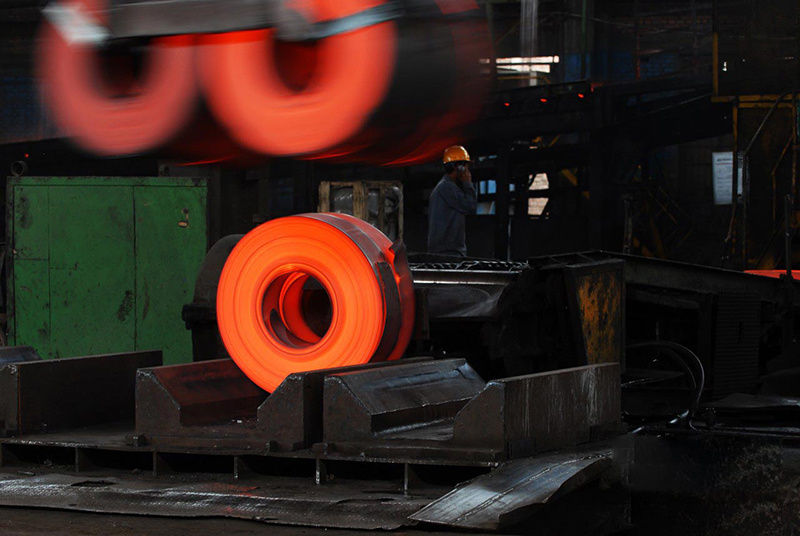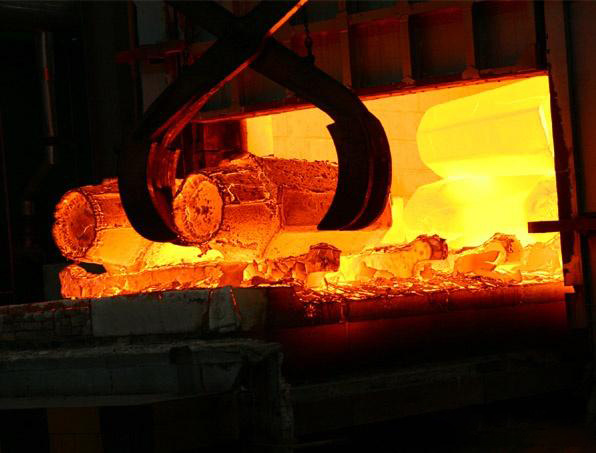Classification, Forging, and Heat Treatment Knowledge of Stainless Steel
Apr 19,2025
Stainless steel refers to steel that does not rust in weakly corrosive media such as atmosphere and fresh water. It is mainly achieved by adding a certain amount of alloying elements such as chromium (Cr) to ordinary steel, forming a dense oxide film (mainly Cr ₂ O3) on the surface of the steel, which can prevent further corrosion of the steel interior by external media. Stainless steel generally has good corrosion resistance, high strength and toughness, and a bright appearance that is easy to clean.
1. Classification of Stainless Steel
1.1 Classification by chemical composition
(1) Chromium stainless steel
Chromium (Cr) is the main alloying element, with a chromium content generally between 12% and 30%. For example, 430 stainless steel in ferritic stainless steel has a chromium content of about 16-18%. It has good corrosion resistance, especially in oxidizing environments. This is because chromium can form a dense chromium oxide (Cr ₂ O3) protective film on the surface of stainless steel, preventing oxygen and other corrosive media from further corroding the metal substrate. This type of stainless steel has a relatively low cost and is commonly used in the manufacturing of kitchen utensils such as pots, bowls, and pans.
(2) Chromium nickel stainless steel
In addition to chromium, it also contains nickel (Ni) element, with a nickel content usually around 8% -25%. A typical representative is austenitic stainless steel 304, with a chromium content of about 18% and a nickel content of about 8-10%. The addition of nickel transforms the crystal structure of stainless steel from body centered cubic (ferrite structure) to face centered cubic (austenite structure). This structure gives it good toughness, processability, and corrosion resistance, and is widely used in many fields such as building decoration (such as stainless steel curtain walls) and chemical equipment (such as reaction vessels).
(3) Chromium manganese nitrogen stainless steel
Partially replacing nickel with manganese (Mn) and nitrogen (N) to stabilize the austenite structure. For example, 201 stainless steel has a lower cost than chromium nickel stainless steel, a higher manganese content of about 7.5%, a nitrogen content of about 0.25%, and a chromium content of about 16-18%. This type of stainless steel is used in some cost sensitive situations where corrosion resistance is not particularly high, such as indoor decorative strips.
1.2 Classification by metallographic structure
(1) Ferritic stainless steel
Its metallographic structure is mainly ferrite, which does not undergo phase transformation during heating and cooling processes. This stainless steel has good corrosion resistance, thermal conductivity, and oxidation resistance. For example, 409L stainless steel is widely used in automotive exhaust systems because it can withstand the corrosion and oxidation of high-temperature exhaust gases, and its cost is relatively low. Its toughness is slightly inferior to austenitic stainless steel and its strength is also lower, but it performs well in some environments that do not require significant external forces.
(2) Austenitic stainless steel
The metallographic structure is austenitic, non-magnetic or weakly magnetic. It has excellent corrosion resistance and can maintain stability in various chemical media. 316L stainless steel, in addition to chromium and nickel, also contains molybdenum (Mo) elements. The addition of molybdenum further enhances its corrosion resistance in highly corrosive media such as chloride ions. This type of stainless steel is commonly used in fields that require high hygiene and corrosion resistance, such as medical equipment (such as surgical instruments) and food processing equipment (such as milk pipes).
(3) Martensitic stainless steel
The martensitic structure is mainly obtained through heat treatment such as quenching and tempering. It has high strength and hardness, as well as a certain degree of corrosion resistance. For example, 420 stainless steel, with a chromium content of about 12-14%, can achieve high hardness through heat treatment and is commonly used in the manufacture of components such as cutting tools and valves that require high strength and certain corrosion resistance.
(4) Duplex stainless steel
Its organization is composed of austenite and ferrite phases, with a ratio of approximately 1:1 between austenite and ferrite phases. Dual phase stainless steel combines the advantages of austenitic stainless steel and ferritic stainless steel, with good strength and toughness, as well as excellent corrosion resistance. For example, 2205 duplex stainless steel is widely used in seawater treatment equipment, chemical pipelines, and other fields because it can resist chloride ion stress corrosion cracking and has higher strength than austenitic stainless steel.
1.3 Classification by purpose
(1) Atmospheric corrosion-resistant stainless steel
This type of stainless steel is mainly used in outdoor environments and can resist corrosive media such as humidity, oxygen, and sulfur dioxide in the atmosphere. If 304 stainless steel is used for exterior decoration of buildings, it can maintain surface gloss and structural integrity under long-term exposure to atmospheric environment.
(2) Acid alkali resistant stainless steel
Used in situations where it comes into contact with various chemicals such as acids and bases. For example, 316L stainless steel is used in the chemical industry to treat equipment containing acidic media such as sulfuric acid and hydrochloric acid. Its molybdenum content makes it more resistant to corrosive ions such as chloride ions.
(3) High temperature resistant stainless steel
Can maintain stable performance in high temperature environments. Such as 310S stainless steel, with a chromium content of about 24-26% and a nickel content of about 19-22%, it can be used at temperatures above 1000 ℃ and is commonly used in the manufacturing of components for high-temperature furnaces, such as furnace tubes.

2. Forging Knowledge of Stainless Steel
2.1 Preparation before forging
(1) Raw material selection
Select appropriate billets based on the final shape and performance requirements of stainless steel products. The blank can be a bar, plate, or ingot. For parts with complex shapes, it may be necessary to choose ingots for forging to ensure material uniformity. At the same time, the size of the blank should be considered, and sufficient machining allowance should be left, generally ranging from a few millimeters to over ten millimeters, depending on the size and accuracy requirements of the part.
(2) Heating equipment
Stainless steel forging requires appropriate heating equipment. The commonly used ones are resistance furnaces and gas furnaces. The resistance furnace has accurate temperature control and high thermal efficiency, which can evenly heat the stainless steel billet. Gas stoves have a faster heating speed, but temperature control is relatively more complex. The control of heating temperature is crucial for stainless steel forging, as different types of stainless steel have different initial and final forging temperature ranges. For example, the initial forging temperature of austenitic stainless steel is generally around 1150-1200 ℃, and the final forging temperature is not lower than 900 ℃.
2.2 Forging process
(1) Forging method
Including free forging and die forging. Free forging has high flexibility and is suitable for small batch production of single pieces or large parts with simple shapes. Forging workers gradually shape the billet by operating forging tools such as air hammers, steam air hammers, etc. Die forging is the use of molds to shape billets, with high production efficiency and suitable for mass production of parts with complex shapes and high dimensional accuracy requirements. For example, stainless steel connecting rods for automobile engines are usually produced by forging.
(2) Forging ratio selection
Forging ratio is an indicator of the degree of metal deformation during the forging process. For stainless steel forging, an appropriate forging ratio can refine the grain size and improve the mechanical properties of the material. Generally, a forging ratio between 3-5 is more suitable. For example, through a forging process with a forging ratio of 4, the grain size of stainless steel can be effectively refined, and its strength and toughness will be improved. However, a high forging ratio may lead to surface cracks and other defects.
(3) Post forging processing
① Clean the surface
After forging, there will be impurities such as oxide scale and lubricant residue on the surface of stainless steel. Cleaning requires methods such as acid washing and shot blasting. Acid washing can remove oxide scale, usually using a nitric acid hydrofluoric acid mixed solution, which can effectively dissolve the oxide layer on the surface of stainless steel. Shot peening is the use of high-speed projectiles to impact the surface, remove impurities from the surface, and generate a certain amount of compressive stress on the surface, thereby improving the fatigue life of the parts.
② Quality inspection
Quality inspection should be conducted on the forged stainless steel parts. Mainly includes dimensional accuracy inspection, surface quality inspection, and internal defect inspection. Dimensional accuracy can be measured using tools such as calipers and micrometers; Surface quality is checked for defects such as cracks and folds through visual observation or the use of non-destructive testing equipment; Internal defects can be detected by ultrasonic testing, radiographic testing, and other methods to ensure that there are no holes, inclusions, or other issues inside the parts.

3. Knowledge of Heat Treatment for Stainless Steel
3.1 Solid solution treatment (for austenitic stainless steel)
(1) Purpose
The main purpose of solid solution treatment is to fully dissolve precipitated phases such as carbides in the austenite matrix, obtain a single-phase austenite structure, and thus improve the corrosion resistance and toughness of stainless steel. For example, after solid solution treatment, the intergranular corrosion resistance of 304 stainless steel is significantly enhanced.
(2) Process technology
Heat stainless steel to a high temperature (usually between 1050-1150 ℃), hold it for a certain period of time (usually 1-2 hours depending on the size of the parts and the amount of furnace load), fully dissolve the alloy elements, and then rapidly cool (usually using water cooling). The purpose of rapid cooling is to prevent the re precipitation of carbides and other substances during the cooling process, thereby maintaining the single-phase austenite structure.
3.2 Quenching and tempering (for martensitic stainless steel)
(1) Quenching purpose and process
The purpose is to obtain martensitic structure and improve the hardness and strength of stainless steel. When quenching, heat martensitic stainless steel to the quenching temperature (such as the quenching temperature of 420 stainless steel is about 1000-1050 ℃), hold for an appropriate period of time, and then cool it by oil cooling or air cooling. Oil cooling can achieve good quenching effect, but attention should be paid to fire safety during operation; The air cooling speed is relatively slow, which is suitable for situations with lower requirements for quenching stress.
(2) Purpose and process of tempering
Tempering is to eliminate quenching stress, stabilize the structure, and improve toughness. The tempering temperature is generally between 200-600 ℃, and the appropriate tempering temperature should be selected according to specific performance requirements. For example, when the tempering temperature is around 400 ℃, it can effectively eliminate quenching stress while maintaining high hardness and strength, making martensitic stainless steel parts less prone to brittle cracking during use.
3.3 Stabilization treatment (for austenitic stainless steel containing titanium or niobium)
(1) Purpose
The purpose of stabilization treatment for austenitic stainless steel containing titanium (Ti) or niobium (Nb) is to prevent intergranular corrosion. In stainless steel, titanium and niobium can combine with carbon to form stable carbides, thereby avoiding the formation of chromium carbide (Cr ₂∝ C ₆) by the combination of chromium and carbon, as the formation of chromium carbide consumes chromium elements, leading to intergranular chromium depletion and reducing the corrosion resistance of stainless steel.
(2) Process technology
Heat stainless steel to 850-900 ℃, hold for 2-4 hours, and then air cool. Through this treatment, titanium or niobium can fully bind with carbon, making stainless steel less prone to intergranular corrosion during subsequent use.

Previous Page
Previous Page:
Latest News
View More


